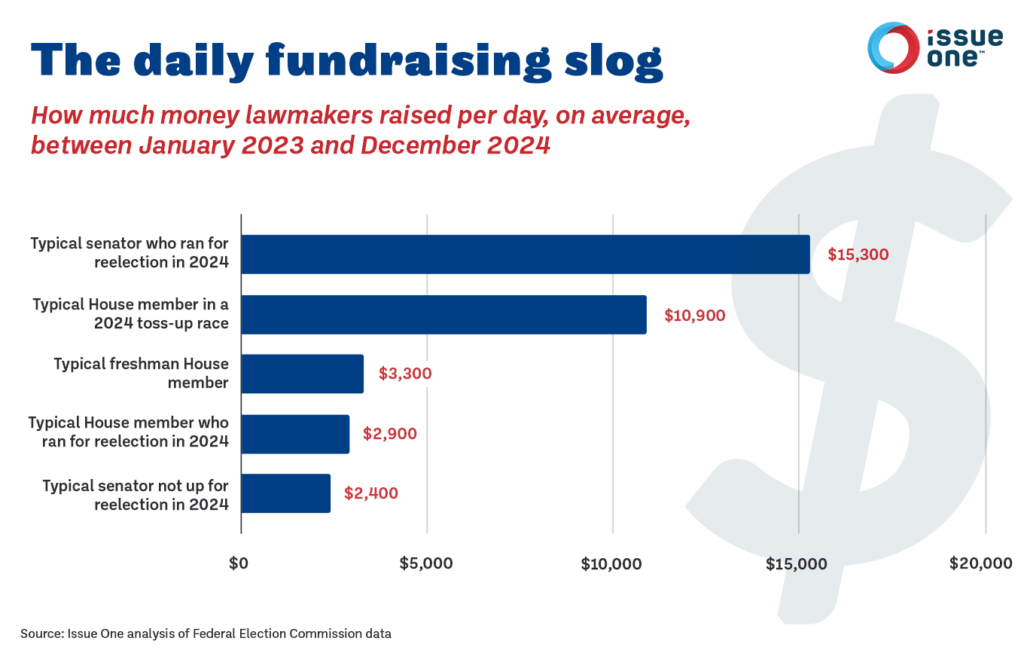The presidential election in 2024 wasn’t the only race setting campaign finance records. Recently filed federal filings illuminate the massive sums House and Senate candidates raised during the 2023-2024 election cycle.
For instance, Issue One’s new analysis shows that the typical House member who ran for reelection in 2024 in a race rated as a “toss-up” by the Cook Political report raised an average of about $10,900 per day, up roughly 50% from the 2022 election cycle. And of the 25 sitting senators who ran for reelection in November, just two — each in tightly contested races — accounted for roughly 30% of the money all senators running for reelection in 2024 collectively raised, each raising more than $123,000 per day.

This fundraising treadmill comes at a steep cost. Hours spent dialing for dollars divert the time and attention of members of Congress away from serving the American people. It’s an open secret that many members of Congress — especially those in the most embattled reelection contests — are encouraged to spend significant amounts of time each week fundraising.
“It’s a sad state of affairs that fundraising has essentially become a second full-time job for most members of Congress — especially those in competitive reelection races,” said Issue One Senior Research Director Michael Beckel. “There are only so many hours in each day. Hours spent dialing for dollars are hours that members of Congress aren’t spending aiding constituents in need, building relationships with other lawmakers, or advancing their important legislative and oversight responsibilities.”
Members of Congress on both sides of the aisle should be united in wanting to get off this fundraising treadmill. In recent years, some proposed reforms have, in fact, garnered bipartisan support.
For instance, in 2022, Reps. Mike Gallagher (R-WI) and Dean Phillips (D-MN) introduced a bipartisan bill that would have prohibited lawmakers from fundraising while Congress is in session. A similar bill was introduced in 2016 by a bipartisan cohort of legislators, led by Rep. David Jolly (R-FL), which would have banned members of Congress from personally soliciting campaign contributions.
And in 2022, even the House Freedom Caucus warned Republican House candidates that “fundraising is all important” and that “every committee assignment comes with a specific fundraising quota attached.”
For now, lawmakers remain under intense pressure to raise money for both their campaigns and their parties, each and every day.
Here are 12 key numbers to know about congressional fundraising during the 118th Congress, based on an Issue One review of recently filed campaign finance reports that cover all lawmakers’ fundraising activities between January 2023 and December 2024.
House of Representatives
- $1.2 billion: Total amount of campaign cash that all House members who ran for reelection in 2024 collectively raised between January 2023 and December 2024. This is up from $1.1 billion during the 2022 election cycle.
- $2.1 million: Median amount of money raised by a House member who ran for reelection in November 2024 – an average of about $2,900 per day.
- $2.4 million: Median amount of money raised by a freshman House member of the 118th Congress – an average of about $3,300 per day and 23% more than the typical non-freshman incumbent House member.
- $7.9 million: Median amount of money raised by a House incumbent who ran for reelection in 2024 in a race rated as a “toss-up” by the Cook Political report — an average of about $10,900 per day, or roughly 3.7 times as much money as the typical House member who ran for reelection. This is up roughly 50% from the 2022 election cycle, when the median House member in a toss up race raised about $5.3 million.
Senate
- $618 million: Total amount of campaign cash that all senators who ran for reelection in 2024 combined to raise between January 2023 and December 2024.
- 30%: Portion of that money raised by just two senators — Sens. Sherrod Brown (D-OH) and Jon Tester (D-MT), who each lost extremely contested reelection bids in November. Between January 2023 and December 2024, Brown raised $97 million and Tester raised $90 million, each raising more than 8 times as much money as the typical senator who ran for reelection elsewhere in 2024.
- $11.1 million: Median amount of money raised by a sitting senator who ran for reelection in November 2024 — an average of about $15,300 per day and 6.4 times as much money as a typical senator who was not up for reelection in 2024.
Leadership PACs
- 95%: Portion of members of the 118th Congress who, as of Election Day in November 2024, had a leadership PAC, a type of political action committee that is operated in addition to lawmakers’ official campaigns that are often criticized by both liberals and conservatives as slush funds that raise most of their money from special interests.
- $260 million: Total amount of money that members of Congress raised for their leadership PACs between January 2023 and December 2024. This is up from $243 million raised between January 2021 and December 2022.
- $177,000 Amount of money the typical member of the 118th Congress with a leadership PAC raised for their leadership PAC between January 2023 and December 2024.
- 13%: Portion of money to Congressional leadership PACs that came from small-dollar donors who gave $200 or less. The rest generally came from wealthy individuals and special interest PACs.
- 43: Number of freshman House members who were sworn into office in January as part of the 119th Congress who had already formed a leadership PAC. Of these, 35 formed a leadership PAC before being elected. As of today, this means 72% of the 60 freshman House members have already formed a leadership PAC. Collectively these leadership PACs raised over $1 million between January 2023 and December 2024.
Oliver Ni contributed to this report.







